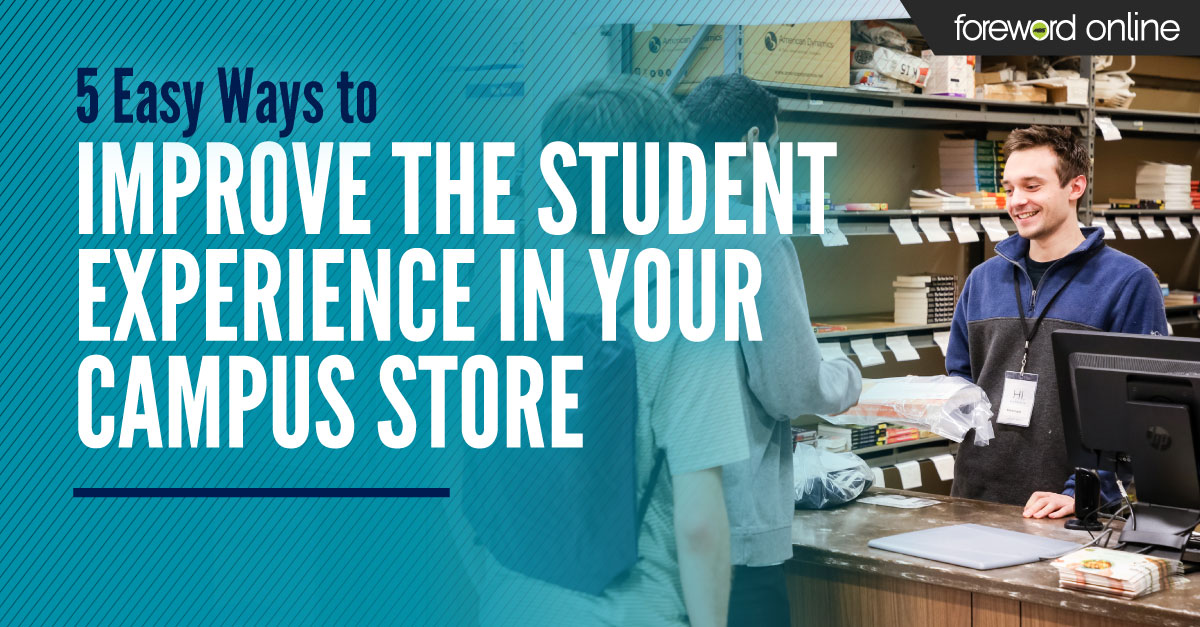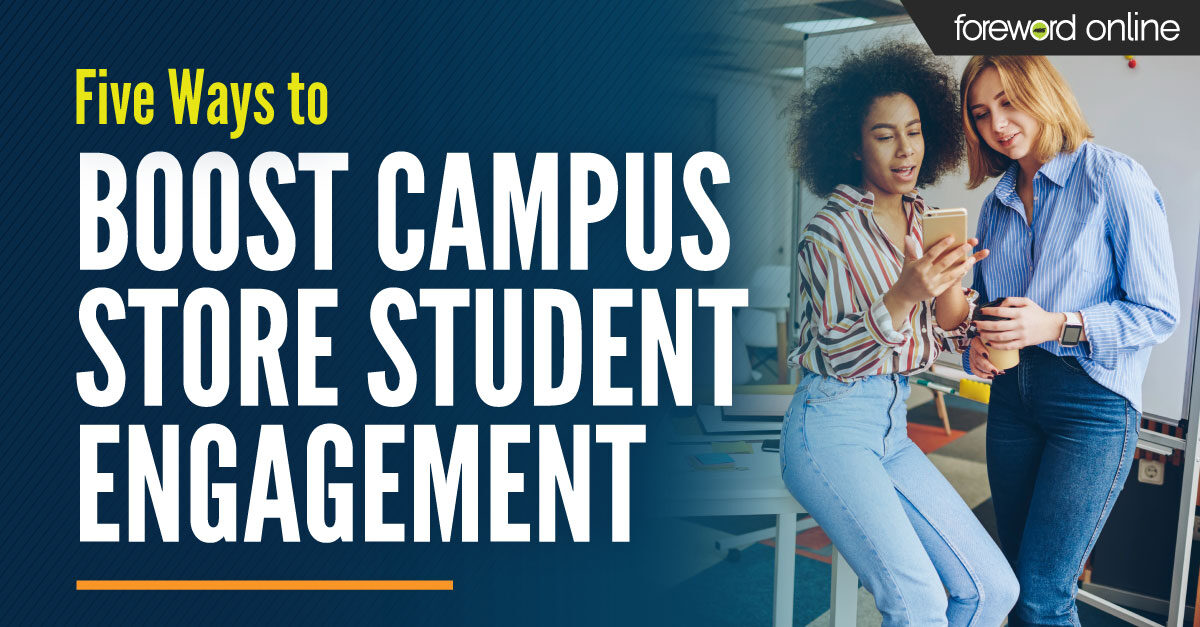Customer experience is a buzzword in the retail world. A great retail experience can change how a customer perceives a store and the store’s brand. However, in a campus store, the impact of a student’s experience with your store extends beyond the walls and brand of your store. It also changes how students view your entire campus.
 Distracted, unfriendly service can make students feel like they are unwanted on campus. Chaotic interactions can make students question how their college operates. Finding significantly lower prices elsewhere can make students think the school only cares about their money. That’s why it’s important for campus stores to be more than just another retail store.
Distracted, unfriendly service can make students feel like they are unwanted on campus. Chaotic interactions can make students question how their college operates. Finding significantly lower prices elsewhere can make students think the school only cares about their money. That’s why it’s important for campus stores to be more than just another retail store.
You care about students and their success, and you recognize that a great student experience is more important than the bottom line. That’s how collegiate retail sets itself apart from the rest of the retail world, both on and offline.
5 simple ways to improve the student experience in your campus store
1. Streamline the student experience during rush
Rush is chaotic, which doesn’t help your store provide a great student experience. Long lines, crowded aisles, busy store associates and hard-to-find textbooks make for a stressful experience. Add to that the hefty price tag often associated with textbooks and many students leave the bookstore unhappy and ready to find other means of acquiring or not acquiring their books.
Savvy stores have found ways to help streamline the experience for students by reorganizing the book by author or by completely changing textbook distribution in the store with counter service.
Madison College Bookstore recently set out to improve its efficiency, decrease overhead and enhance the student experience with counter service.
“Before we switched to counter service, we noticed that during the rush periods store employees would have students following them through the stacks in a single-file line, waiting for their turn to be helped. Sometimes there were as many as 10 students in line, just following our staff up and down the aisles as they were helping another person,” Madison College Bookstore Manager Scott Heiman “Students were just overwhelmed by the number of people in the aisles, how many books were on the shelves and having to decipher the course numbers on the shelf tags. Students would come to us to ask for help, but so many people were in the aisles that we couldn’t even access shelves.”
Since the change, students have gotten better, faster service, and store returns have gone down.
“The first couple days of the semester, I like to spend time in the front as a store greeter. I ask people how long they had to stand in line and how everything worked for them and whether they got what they needed,” Heiman said. “The feedback I get from the majority of people is that everything worked great. They say things like, “It is so much faster than I thought it would be,” or “I got what I needed and didn’t have to look for it. All they wanted was my ID.” So, most of the people are very happy about it.”
Read more about Madison College Bookstore’s switch to counter service.
2. Improve transparency with electronic shelf labels
Electronic shelf labels are an easy way for stores to supply students with a lot of useful information upfront. With electronic shelf labels, stores can give students an in-store experience that makes information as easily accessible as it is online.
You can let students know the quantities you have, whether books are out of stock and formats available. They are also integrated with your system for easy, instant updates, saving employees time during the busiest part of the year.
North Dakota State University Bookstore made the switch to electronic shelf labels. They immediately saw an impact on the amount of time devoted to updating shelf labels and an improvement to how students experience the store.
“Our customer service desk used to be inundated with people asking when books would come in. Now that we don’t have to do the labor-intensive changing of tags, we save the labor of one full time employee who used to be in charge of changing physical shelf tags every term — which helps our bottom line. This semester that employee had more time to do more outreach with faculty,” NDSU Bookstore Director Kim Anvinson “The digital tags are fantastic. If the price is wrong, we can get that updated right away. They especially help when we have a book out of stock. We can assist the students right there. Or, if we aren’t with the student, they can see if the books are on order.”
Read more about the updates North Dakota State University made to improve student affordability.
3. Tailor your efforts when marketing to college students
Students don’t have to be in your store to interact with your brand. In the hyperconnected world, in-store and omnichannel experiences should blend together seamlessly. Therefore, the experience you provide customers on your website, app and social media channels needs to be as exceptional as the service you provide in your store.
Research shows that 55 percent of Gen Z can’t unplug for more than five hours, 68 percent believe that websites will intuitively know what they want and 44 percent provide data to personalize their experience.
A simple way to begin enhancing your store’s personalization efforts is with social media.
The GVSU Laker Store at Grand Valley University personalizes their campus store social media channels by asking student employees to model their merchandise for social media images and by varying the content shared on each platform to best appeal to different audiences.
“Our Instagram page is primarily followed by students. It’s a younger audience and mostly female. Our school has a higher female population, so that is pretty consistent. With Facebook we see students, but we also see parents and alumni there. We get a lot of instances where we post something on Facebook, and then a parent will tag a student in the post, saying things like, ‘Hey, check out what the bookstore posted.’” GVSU Auxiliary Services Marketing Manager Liza Guikema “We try to be more formal and informative on Facebook. We share when to buy books, when to sell back books, deadlines for financial aid, etc. We know that parents are sometimes the ones to motivate students to get things done, so it helps that they are aware of the deadlines. With Twitter, we also have a younger audience. There, things like humor, memes, GIFs and more casual posts do well.”
Read more about GVSU Laker Store’s social media strategy.
4. Provide a convenient eCommerce site
As discussed above, you must strengthen your omnichannel presence as part of improving the student experience with your campus store. Your store’s eCommerce site is a big part of that. On your website, student can have access to the same merchandise they can find in-store, but they also have even more convenient shopping options like creating a wish list or being able to easily read customer reviews.
Customer reviews have become an essential part of the Gen Z shopping experience. In fact, more than 60 percent of surveyed shoppers use apps to leave product reviews and 34 percent use them to get product recommendations. By enabling reviews on your eCommerce site, student shoppers have a way to easily research products and get real-life feedback without having to go to other websites.
In addition, your campus store eCommerce site can help expand your campus store’s market and better streamline textbook orders. When the KU Bookstore’s customer base ballooned, it became difficult to provide students with the level of service they had come to expect from the campus store. As a solution, the store decided to incentivize online orders to help managed in-store foot traffic.
“Our customer base had really grown to critical mass, and it threatened our ability to serve customers. So we wanted to develop a way to continue to grow without being overrun the first week of class,” KU Bookstore Textbook Manager Kyle Whitley “The Textbook Door Delivery program really came from that. At its core, it is a free shipping promotion to incentivize online ordering. Basically, the program encourages students to preorder their textbooks. We have a campus initiative to ensure students have their books by the start of class. So the last day of the promotion corresponds to the date when we would need to ship the order.”
Read more about KU Bookstore’s success with textbook door delivery.
5. Ensure student satisfaction with price matching
It’s disappointing to make a purchase only to see the same product offered for a lower price somewhere else. For many college students, saving even a few dollars has a big impact on their day-to-day life. Price matching is a simple way to demonstrate to students that you understand their situation and that your store cares about them.
Just knowing that the college store is willing to match lower prices can be the difference between shopping in the campus store with confidence and scouring the web for a better deal. College stores like San Diego State Bookstore even take price matching a step further.
“We let people know how they can save the most money on textbooks. They really appreciate that transparency. We also share information on our programs like our price comparison tool with them,” Aztec Shops Director-Campus Store Division Kathy Brown “We also have Price Match-PLUS. This program offers students price matching plus an additional 5 percent off the lowest price.”
By giving students the best deal possible, student shoppers can easily see how their campus store is different than other retailers.
“I really do see it as part of my job to help the students. With the cost of textbooks going up, we really have to work to lower costs even if that means cutting our margin,” Brown said. “It’s a hard pill to swallow to have to go to your boss and say we’re going to lower our margins, but it’s the right thing to do.”
Read more about how SDSU Bookstore enhances college affordability at San Diego State University.
Explore small changes your store can make that will have a big impact on the customer experience you provide. Start with the areas that have the most room for improvement like rush or your omnichannel presence. Invest in these areas to improve the student experience and help your store operate more efficiently.




